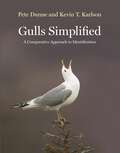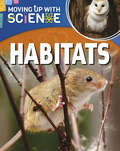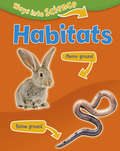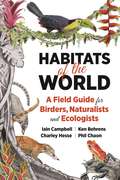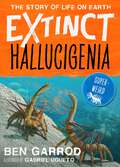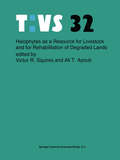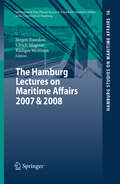- Table View
- List View
Gulls of the World: A Photographic Guide
by Klaus Malling OlsenThis book represents the definitive photographic guide to gulls, by the world's greatest authority on gull identification, Klaus Malling Olsen.This outstanding new guide covers all of the world's gull species, tackling some of the most notoriously difficult identification and taxonomic challenges in birding. Concise text - complemented by an accurate colour range map - places particular emphasis on field identification, with detailed discussion of variation, and coverage of habitat, status and distribution. Each photograph has been carefully selected to highlight identification criteria and, crucially, to allow age and subspecific separation in the field. This book is an invaluable tool for identifying gulls, featuring the most sought-after rarities as well as beautiful, easy-to-identify species.
Gulls of the World: A Photographic Guide
by Klaus Malling OlsenONE OF THE BB/BTO BEST BIRD BOOKS OF THE YEAR, 2018This book represents the definitive photographic guide to gulls, by the world's greatest authority on gull identification, Klaus Malling Olsen.This outstanding new guide covers all of the world's gull species, tackling some of the most notoriously difficult identification and taxonomic challenges in birding. Concise text - complemented by an accurate colour range map - places particular emphasis on field identification, with detailed discussion of variation, and coverage of habitat, status and distribution. Each photograph has been carefully selected to highlight identification criteria and, crucially, to allow age and subspecific separation in the field. This book is an invaluable tool for identifying gulls, featuring the most sought-after rarities as well as beautiful, easy-to-identify species.
Gulls Simplified: A Comparative Approach to Identification
by Pete Dunne Kevin KarlsonA simpler and more user-friendly visual approach to gull identificationThis unique photographic field guide to North America’s gulls provides a comparative approach to identification that concentrates on the size, structure, and basic plumage features of gulls—gone are the often-confusing array of plumage details found in traditional guides.Featuring hundreds of color photos throughout, Gulls Simplified illustrates the variations of gull plumages for a variety of ages, giving readers strong visual reference points for each species. Extensive captions accompany the photos, which include comparative photo arrays, digitized photo arrays for each age group, and numerous images of each species—a wealth of visual information at your fingertips. This one-of-a-kind guide includes detailed species accounts and a distribution map for each gull.An essential field companion for North American birders, Gulls Simplified reduces the confusion commonly associated with gull identification, offering a more user-friendly way of observing these marvelous birds.Provides a simpler approach to gull identificationFeatures a wealth of color photos for easy comparison among speciesIncludes detailed captions that explain identification criteria and aging, with direct visual reinforcement above the captionsCombines plumage details with a focus on size, body shape, and structural features for easy identification in the fieldHighlights important field marks and physical features for each gull
Gully Erosion Studies from India and Surrounding Regions (Advances in Science, Technology & Innovation)
by Pravat Kumar Shit Hamid Reza Pourghasemi Gouri Sankar BhuniaThis book offers the scientific basis for the ample evaluation of badland management in India and some surrounding regions. It examines the processes operating in the headwaters and main channels of ephemeral rivers in lateritic environments of India. In particular, the book covers a range of vital topics in the areas of gully erosion and water to soil erosion at lateritic uplands regions of India and other regions in Asia. It explores the probable gully erosion modeling through Remote Sensing & GIS Techniques. It is divided into three units. Unit I deals with the introduction of badland, types of badland and the process of badland formation. Unit II is devoted to a description of quantitative measurements. Unit III deals with the control and management processes related to various issues from different regions. As such this book serves as a reference book for research activities in this area. It is an efficient guide for aspiring researchers in applied geography, explaining advanced techniques to help students recognize both simple and complex concepts.
Guns, Germs And Steel: A Short History Of Everybody For The Lst 13,000 Years (Patterns Of Life Ser.)
by Jared Diamond'A book of big questions, and big answers' Yuval Noah Harari, bestselling author of SapiensWITH A NEW AFTERWORD FROM THE AUTHOR Why has human history unfolded so differently across the globe?In his Pulitzer Prize-winning book, Jared Diamond puts the case that geography and biogeography, not race, moulded the contrasting fates of Europeans, Asians, Native Americans, sub-Saharan Africans, and aboriginal Australians. An ambitious synthesis of history, biology, ecology and linguistics, Guns, Germs and Steel remains a ground-breaking and humane work of popular science.
H is for Hawk: A BBC2 Between the Covers pick
by Helen MacdonaldTHE NUMBER ONE BESTSELLER**WINNER OF THE COSTA BOOK OF THE YEAR****WINNER OF THE SAMUEL JOHNSON PRIZE FOR NON-FICTION****WINNER OF THE PRIX DU MEILLEUR LIVRE ÉTRANGER**As a child, Helen Macdonald was determined to become a falconer, learning the arcane terminology and reading all the classic books. Years later, when her father died and she was struck deeply by grief, she became obsessed with the idea of training her own goshawk. She bought Mabel for £800 on a Scottish quayside and took her home to Cambridge, ready to embark on the long, strange business of trying to train this wildest of animals. H is for Hawk is an unflinchingly honest account of Macdonald's struggle with grief during the difficult process of the hawk's taming and her own untaming. This is a book about memory, nature and nation, and how it might be possible to reconcile death with life and love.
Habitats: Above Ground - Below Ground (Moving up with Science #8)
by Peter RileyFind out all about the science in the world around us with Moving Up with Science. Written to support the National Curriculum at Key Stage 2, each title explores key scientific topics through a combination of concise information and fun experiments. Find out about forest and water homes; the importance of food chains and why humans are changing habitats. Explore different plant and animal groups and discover how a woodland changes with the seasons.
Habitats: Above Ground - Below Ground (Ways Into Science #5)
by Peter RileyA first science series that introduces young readers to basic science principles in a friendly and accessible way. Early scientific skills are taught through a combination of experiments, activities and key questions, designed to get young scientists thinking!Habitats explores the different places where plants and animals make their homes, and explains how they are suited to these different habitats.
The Habitats Directive: A Developer's Obstacle Course?
by Gregory Jones QcBiodiversity within the European Union is under threat. Almost a quarter of Europe's vascular plant species and 155 species of its native mammals, birds, reptiles and amphibians are threatened with extinction. The Habitats Directive imposes a strict regime for environmental protection. But with the euro zone economy falling from 'stagnation' to 'contraction' in the second quarter of 2012 and the UK entering into a 'double dip' recession in April 2012, European governments face an economic crisis. The English courts have said that the Directive should not become a property developer's obstacle course. Yet the tensions between environmental protection and economic growth are all too readily apparent with the UK government stating both that we must 'arrest the decline in habitats and species and the degradation of landscapes' and later that 'gold plating of EU rules on things like habitats' was putting 'ridiculous costs' on business enterprise. Edited by Gregory Jones QC, The Habitats Directive: A Developer's Obstacle Course? brings together a unique combination of leading academics and practitioners in the field of European environmental and planning law to address and debate controversial issues arising from the Habitats Directive in an authoritative and practical manner. A must for anyone engaged in property development, planning and environmental law.
The Habitats Directive: A Developer's Obstacle Course?
by Gregory Jones QcBiodiversity within the European Union is under threat. Almost a quarter of Europe's vascular plant species and 155 species of its native mammals, birds, reptiles and amphibians are threatened with extinction. The Habitats Directive imposes a strict regime for environmental protection. But with the euro zone economy falling from 'stagnation' to 'contraction' in the second quarter of 2012 and the UK entering into a 'double dip' recession in April 2012, European governments face an economic crisis. The English courts have said that the Directive should not become a property developer's obstacle course. Yet the tensions between environmental protection and economic growth are all too readily apparent with the UK government stating both that we must 'arrest the decline in habitats and species and the degradation of landscapes' and later that 'gold plating of EU rules on things like habitats' was putting 'ridiculous costs' on business enterprise. Edited by Gregory Jones QC, The Habitats Directive: A Developer's Obstacle Course? brings together a unique combination of leading academics and practitioners in the field of European environmental and planning law to address and debate controversial issues arising from the Habitats Directive in an authoritative and practical manner. A must for anyone engaged in property development, planning and environmental law.
The Habitats Directive in its EU Environmental Law Context: European Nature’s Best Hope? (Routledge Research in EU Law)
by Charles-Hubert Born An Cliquet Hendrik Schoukens Delphine Misonne Geert Van HoorickThis book analyses the Habitats Directive; one of the most prominent piece of EU environmental legislation of the past decades. Seen by some as the cornerstone of Europe’s nature conservation policy, among other measures the Directive established the so-called "Natura 2000" ecological network, which covers more than 18% of the surface of the EU. However, despite the fact the Directive was adopted over twenty years ago only 17% of the protected habitats and species in Europe are being adequately protected while 10-60 % of animal species remain under threat. In light of the limited success and the contested nature of the Habitats Directive so far this book examines the successes and failures of the Habitats Directive from a legal and political angle. The book brings together international experts to consider the application, implementation and future of the Habitats Directive in order to assess whether the Habitats Directive is resilient enough to tackle biodiversity loss in the twenty- first century. Particular emphasis is put on the legal regime attached to the Natura 2000 network and its possible impact on land development and the relationship between the Habitats Directive and other topics including liability for ecological damage and transboundary nature conservation.
The Habitats Directive in its EU Environmental Law Context: European Nature’s Best Hope? (Routledge Research in EU Law)
by Charles-Hubert Born An Cliquet Hendrik Schoukens Delphine Misonne Geert Van HoorickThis book analyses the Habitats Directive; one of the most prominent piece of EU environmental legislation of the past decades. Seen by some as the cornerstone of Europe’s nature conservation policy, among other measures the Directive established the so-called "Natura 2000" ecological network, which covers more than 18% of the surface of the EU. However, despite the fact the Directive was adopted over twenty years ago only 17% of the protected habitats and species in Europe are being adequately protected while 10-60 % of animal species remain under threat. In light of the limited success and the contested nature of the Habitats Directive so far this book examines the successes and failures of the Habitats Directive from a legal and political angle. The book brings together international experts to consider the application, implementation and future of the Habitats Directive in order to assess whether the Habitats Directive is resilient enough to tackle biodiversity loss in the twenty- first century. Particular emphasis is put on the legal regime attached to the Natura 2000 network and its possible impact on land development and the relationship between the Habitats Directive and other topics including liability for ecological damage and transboundary nature conservation.
Habitats of the World: A Field Guide for Birders, Naturalists, and Ecologists
by Iain Campbell Ken Behrens Charley Hesse Phil ChaonThe first field guide to all of the world’s major land habitats—richly illustrated and packed with essential information to help you get the most out of your outdoor adventuresAccurately identifying and understanding habitats in detail is essential to any birder, naturalist, outdoor enthusiast, or ecologist who wants to get the most out of their experiences in the field. Habitats of the World is the first field guide to the world’s major land habitats—189 in all. Using the format of a natural history field guide, this compact, accessible, and comprehensive book features concise identification descriptions and is richly illustrated—including more than 650 color photographs of habitats and their wildlife, 150 distribution maps, 200 diagrams, and 150 silhouettes depicting each habitat alongside a human figure, providing an immediate grasp of its look and scale. Each major habitat has an illustrated “climate box” that allows easy comparisons between habitats. Thirty other illustrated boxes present clear explanations of complex phenomena affecting habitats—from plate tectonics and mountain formation to fire regimes and climate change. Requiring no scientific background, Habitats of the World offers quick and reliable information for anyone who wants a deeper understanding and appreciation of the habitats around them, whether in their own backyard or while travelling anywhere in the world.Covers 189 of the world’s major land habitatsProvides all the information you need to quickly and accurately identify and understand habitats anywhere in the worldFeatures concise text, more than 650 color photographs of habitats and their wildlife, an up-to-date distribution map for each habitat, and hundreds of helpful diagrams and illustrations
Haftung und Entschädigung nach Tankerunfällen auf See: Bestandsaufnahme, Rechtsvergleich und Überlegungen de lege ferenda (Hamburg Studies on Maritime Affairs #6)
by Rainer AltfuldischKritischer Beitrag zur aktuellen Diskussion um die Änderung des internationalen Haftungs- und Entschädigungssystems bei Tankerunfällen auf See. Das seit 1969 bestehende und 1992 nur gering überarbeitete System geriet nach den Unfällen der "Erika" (1999) und "Prestige" (2002) zunehmend in die Kritik. Der Autor analysiert das internationale Haftungs- und Entschädigungssystem, die aktuelle Rechtsprechung und setzt sich hiermit auseinander.
Haftung und Versicherung für Umweltschäden aus ökonomischer und juristischer Sicht (Ladenburger Kolleg Studien zum Umweltstaat)
by Alfred Endres Eckard Rehbinder Reimund SchwarzeHagfish Slime and Lobster Rolls (Chicago Shorts)
by Ellen PragerWhen viewed from a quiet beach, the ocean, with its rolling waves and vast expanse, can seem calm, even serene. But hidden beneath the sea’s waves are a staggering abundance and variety of active creatures, engaged in the never-ending struggles of life—to reproduce, to eat, and to avoid being eaten. With Hagfish Slime and Lobster Rolls, marine scientist Ellen Prager takes us deep into the sea to introduce an astonishing cast of fascinating and bizarre creatures that make the salty depths their home, with the help of stunning color photos. From the lobsters that battle rivals or seduce mates with their urine to hagfish that ties itself into a knot to keep from suffocating in its own slime—there’s far more to Prager’s account than her ever-entertaining anecdotes. Again and again, she illustrates the crucial connections between life in the ocean and humankind, enchanting us as she educates, enthralling us with the wealth of life in the sea, and reminding us of our need to protect it.
The Hairy Hikers: A Coast-to-Coast Trek Along the French Pyrenees
by David Le VayFuelled by a mid-life crisis and the need to escape modern life, David and Rob set out to walk from the Atlantic to the Mediterranean. This humorous and often poignant account of their coast-to-coast trek along the French Pyrenees, reveals the history and geography along the way and will appeal to all walkers and admirers of human endeavour.
Hairy Hippies and Bloody Butchers: The Greenpeace Anti-Whaling Campaign in Norway (Protest, Culture & Society #21)
by Juliane RieseIn the popular imagination, no issue has been more closely linked with the environmental group Greenpeace than whaling. Opposition to commercial whaling has inspired many of the organization’s most dramatic and high-profile “direct actions”—as well as some of its most notable failures. This book provides an inside look at one such instance: Greenpeace’s decades-long campaign against the Norwegian whaling industry. Combining historical narrative with systems-theory analysis, author Juliane Riese shows how the organization’s self-presentation as a David pitted against whale-butchering Goliaths was turned on its head. She recounts how opponents successfully discredited the campaign while Greenpeace struggled with internal disagreements and other organizational challenges, providing valuable lessons for other protest movements.
Hallucigenia (Extinct the Story of Life on Earth #1)
by Ben GarrodTV scientist Ben Garrod presents the biggest extinction events ever, told from the point of view of evolution's superstars, the most incredible animals ever to swim, stalk, slither or walk our planet. Whether you're 9 or 90, his unique exploration of the most destructive, yet most creative, force in nature makes top level science fun. Here are the superstars of the story of life, from the super-weird to the super-ferocious. Usually a species has 10 million years or so of evolving, eating, chasing, playing, maybe doing homework, or even going to the moon before it goes extinct.Hallucigenia was a super-weird, spiky, armoured worm that lived 450 million years ago. Scientists were, at first, unsure of which way round it went, and which way up. But here you will discover all Hallucigenia's secrets: where it lived, what it ate, why it was so weird and why it is so important in the story of life.'Eye-opening science with striking artwork' Sunday Times 'Best Children's Books for Summer 2021'Collect all eight books about animals we have lost in mass extinctions caused by asteroids or mega-volcanoes, clashing continents and climate change.Also includes: * Past brought to full-colour life by palaeoartist Gabriel Ugueto * Ask an Expert contributions from leading scientists * Glossary and pronunciation guide
Halophilic Microorganisms and their Environments (Cellular Origin, Life in Extreme Habitats and Astrobiology #5)
by Aharon Oren"This water" he told me, "runs out to the eastern region, and flows into the Arabah; and when it comes into the sea, into the sea of foul waters [i. e. , the Dead Sea], the water will become wholesome. Every living creature that swarms will be able to live wherever this stream goes; the fish will be very abundant once these waters have reached there. It will be wholesome, and everything will live wherever this stream goes. Fishermen shall stand beside it all the way from En-gedi to En-eglaim; it shall be a place for drying nets; and the fish will be of various kinds [and] most plentiful, like the fish of the Great Sea. " Ezekiel’s prophecy (Ezekiel 47: 8-10) for revival and purification of the Dead Sea waters This new book on "Halophilic Microorganisms and their Environments" is the fifth volume in the COLE series (Cellular Origin and Life in Extreme Habitats (see: http://www. wkap. nl/prod/s/COLE). In the previous books we covered aspects of enigmatic microorganisms, microbial diversity, astrobiology, and symbiosis, so this book on halophilic microbes adds a fitting link to the rest of series' books. Since ancient times hypersaline habitats have been considered extreme environments, and some were thought not to sustain life at all. Yet, every organism requires salt for its existence. Salty places have been compared to an environment of extinction (e. g. , the Dead Sea).
Halophyte Plant Diversity and Public Health
by Münir Öztürk Volkan Altay Moona Nazish Mushtaq Ahmad Muhammad ZafarSalinity is one of the acute problems causing enormous yield loss in many regions of the world. This phenomenon is particularly pronounced in arid and semiarid regions. Halophytes can remove salt from various types of problematic soils due to their unique morphological, physiological and anatomical adaptations to these environments. Halophytes are also used for the treatment of certain diseases but scientific documentation in terms of current phytotherapic applications is deficient in this unique group of plants. Different ethnic groups around the world use medicinal halophytes according to their own beliefs and ancestor’s experiences. However, their knowledge about the use of salt tolerant medicinal plants is usually confined to their own community. There is thus a knowledge gap on halophytes which should be bridged and preserved. This book provides a comprehensive account on the distribution of halophytes, their ethnobotanical and medicinal aspects, economic importance, and chemical constituents along with scientific description. The book therefore serves as a valuable resource for professionals and researchers working in the fields of plant stress biology and ethnobotanical aspects.
Halophytes as a resource for livestock and for rehabilitation of degraded lands (Tasks for Vegetation Science #32)
by V. Squires A. T. AyoubDesertification (land degradation in arid, semi-arid and dry sub-humid areas resulting mainly from adverse human impacts) is the main environmental problem of dry lands, which occupy more than 40 per cent of the total global land area. The phenomenon threatens about 3.6 billion hectares and currently affects the livelihood of about 900 million people. Thl! world is now losing annually about 1.5 million hectares of total irrigated lands (240 million hectares) due mostly to salinization, mainly in drylands. Salt affected soils are widely distributed throughout the arid and semi-arid regions, and particularly severe in China (7 million ha), India (20 million ha), Pakistan (3.2 million ha), USA (5.2 million ha), as well as Near East, southern Europe and elsewhere. Demands on production have increased the pressure on existing productive land and moved the limits of production onto increasingly marginal lands. Wise land-use practices have yet to be developed for such conditions. The Executive Director of UNEP reported to the Governing Council in February 1992 concerning the "Status of Desertification and Implementation of the United Nations Plan of Action to Comtat Desertification (PACD)". The Report concludes that major efforts to implement the PACD had gJne into supporting measures rather than concrete corrective field operations. Little evidence of progrl!ss was found in irrigated croplands, rainfed croplands or rangelands. It was recommended that every piece of land should be used in keeping with its ecological characteristics, natural capabilities and constraints.
The Hamburg Lectures on Maritime Affairs 2007 & 2008 (Hamburg Studies on Maritime Affairs #16)
by Jürgen Basedow Ulrich Magnus Rüdiger WolfrumIn 2007, the International Max Planck Research School for Maritime Affairs and the International Tribunal for the Law of the Sea (ITLOS), both based in Hamburg, decided to establish an annual lecture series, the "Hamburg Lectures on Maritime Affairs" – giving distinguished scholars and practitioners the opportunity to present and discuss recent developments in the field of maritime affairs. The present volume collects seven of the lectures held in 2007 and 2008 by Thomas A. Mensah, Krijn Haak, Sergio M. Carbone, Lorenzo Schiano di Pepe, Erik Røsæg, Frank Smeele, Carlos Esplugues Mota and Lucius Caflisch.
Hamburger Klimabericht – Wissen über Klima, Klimawandel und Auswirkungen in Hamburg und Norddeutschland
by Hans Von Storch Insa Meinke Martin ClaußenBereits zum zweiten Mal wird im Rahmen des KlimaCampus Hamburg der aktuelle Forschungsstand zum Klimawandel in der Hamburger Metropolregion und Norddeutschland systematisch dokumentiert. Erfahren sie auf Basis der Fachliteratur in welchem Maße Konsens hinsichtlich des Klimawandels in Norddeutschland besteht.Inwieweit sind Entwicklungen bereits messbar, welche Auswirkungen zeigen sich bereits heute und wie kann sich die Region vor negativen Folgen des Klimawandels schützen? Die über 70 Autoren haben die Forschungsergebnisse zu diesen Fragen systematisch zusammengetragen. Die Übereinstimmung bzw. Widersprüchlichkeit des derzeitigen Wissens wurde dabei herausgearbeitet, Erkenntnisgewinne gegenüber dem ersten Hamburger Klimabericht lokalisiert und weiterhin bestehender Forschungsbedarf aufgezeigt. Alle Beiträge wurden einem wissenschaftlichen Begutachtungsprozess unterzogen, der von einem Lenkungsausschuss überwacht wurde.Die Dokumentation belegt umfassend eine bereits stattfindende Erwärmung in der Metropolregion Hamburg und in Norddeutschland, sowie einen Meeresspiegelanstieg an Nord- und Ostsee. Mit der Erwärmung zeichnen sich deutliche Änderung im Ökosystem ab. Diese bereits eingetretenen Entwicklungen können sich künftig weiter verstärken. Erfahren Sie, welche Auswirkungen dies für Politik, Wirtschaft und Gesellschaft hat.Dieses Buch ist eine Open-Acess-Publikation unter einer CC BY-NC 4.0 Lizenz
Hammer Time: Me, West Ham, and a Passion for the Shirt
by Julian DicksFrom West Ham's cult hero, Julian Dicks, a hugely entertaining romp through football and the East End of the Eighties and Nineties.'Cult figure' is a term hardly used in football these days: where have they all gone? In the sterile and corporate modern game, is there room for the mercurial midfielder or the tough-tackling defender or the pot-bellied goal poacher? Rewind two or three decades and British professional football was stuffed to the gunnels with these 'one-offs': players with bags of talent, yes, but also lorryloads of personality and a hugely relatable quality which meant they'd all be playing Sunday morning park football if they hadn't become professionals. No media training, no filter, no 5% body fat, no cryotherapy chambers, and no quiet nights in with a curly kale salad and a glass of carrot juice. Meet Julian Dicks. Wonderful name, wonderful player and undoubtedly one of the greatest cult figures to play for West Ham United.Hammer Time is Dicks' hugely entertaining romp through his career with West Ham, shot through with all the great anecdotes of life as a pro back then, and peppered with all the marvellous characters who crossed his path in those halcyon days. It evokes memories of intimidating away crowds, muddy pitches, no-nonsense tackling, card schools on the bus, big nights out after matches, and the special camaraderie that was forged between players of that era.Hammer Time is also an open love letter to the unique character and atmosphere of West Ham United and East London, conjuring up - with great warmth and nostalgia - a fast disappearing world of strong working-class communities, proper East End boozers and those iconic pie and mash shops.


